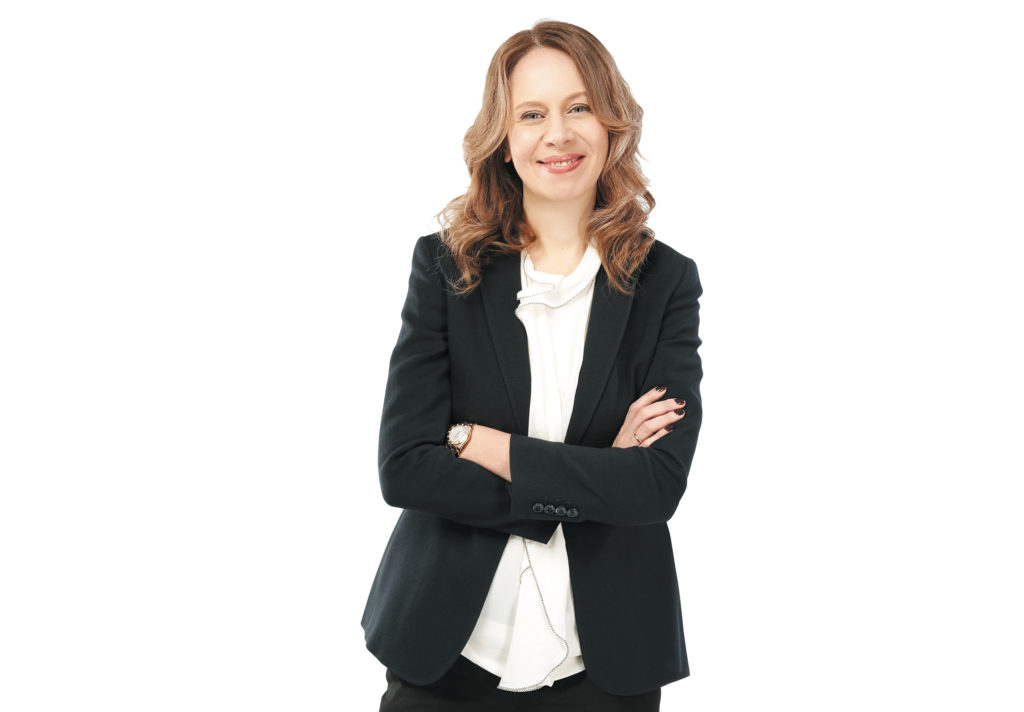INTERVIEW BY FASTMARKETS RISI
FASTMARKETS RISI: Ilim has an ambitious development strategy. Under your leadership during the last four years, what has had the biggest impact on the company’s growth and what have been the most significant challenges?
Sosnina: Indeed, our company is implementing a large-scale investment program with strategic CAPEX allocation of around US$2 billion. In 2018-2019, Ilim completed several important projects in Siberia, including the rebuild and launch of a kraftliner machine in Bratsk and a pulp line retrofit in Ust-Ilimsk, along with a number of environmental, efficiency, and modernization-driven investments. Ilim continues to implement the big Ust-Ilimsk project, which involves the construction of the largest pulp and board mill with an annual capacity of 600,000 metric tpy. This large-scale project is worth US$1 billion. Upon its completion and along with the capacity expansion at the Bratsk Mill, Ilim will become one of the largest manufacturers of unbleached packaging materials globally, bringing the aggregate production output of Ilim Group to more than 4.4 million metric tpy of pulp and paper (P&P) products by 2023. The project is welcomed by our strategic customers in China and the rest of Asia, and we look forward to completing it.

Speaking about the challenges, first of all, the global environment is very volatile and the political agenda has had a major impact on the economy. For example, the US-China trade war has created even more uncertainty for market players. China’s demographic shift, the economic slowdown, and “black swans” like the Covid-19 epidemic will continue to impact the global supply-demand balance. We should look at this in a very responsible way, make well-weighed investment decisions, balance our business portfolio, and remain flexible throughout the execution of the strategy and business plan.
Given the recent challenging market conditions, is Ilim postponing any of the previously announced projects or adjusting the schedule for their implementation?
We will not curtail previously announced projects nor reconsider key project parameters, as we maintain our long-term view; but I would certainly allow some room for maneuvering. As I mentioned before, flexibility is the name of the game. Agility, if you will. We are not going to do projects for the sake of the projects. Our goal is to grow the value of our business to the benefit of the shareholders, employees, customers, and the communities we live in.
Since you started working for Stora Enso, how have the industry and market trends changed?
I started in 1998 and have been working in the sector for more than 20 years; in my view, the industry development is incredible. I remember very well the times when discussions about China growth and eucalyptus plantations in Latin America sounded fresh. Online trade and “smart packaging” were among the new trends. Declining of white papers demand was expected, and first capacity closures and conversions had been announced.
Now we are into modeling of the forestry operations, routine forest spatial monitoring, AI, preventive maintenance, remote mill control, digital twins, and so forth. What we see in the near future: bans on single-use plastic, autonomous vehicles, precision forestry, and engineered wood. Our industry is speeding ahead with the rest of the world, and it became very obvious that the key development areas will be defined by the needs of the large numbers of consumers living in a digital world, the urbanized community lifestyle, mass migration, health and environmental awareness, public opinion formed by social media, and similar.
During your tenure, llim has invested significant resources into projects to improve the company’s environmental impact. What do you consider as the most important among those that have been completed? Are you planning more?
Ilim has had a focus on environmental improvements for much longer then I’ve worked here. This is challenging, since the assets were originally built during the Soviet era, in remote locations and tough climates, with old infrastructure. This makes any project capital intensive. We have goals to reduce the environmental footprint using global best practices and Ilim will continue to make substantial investments in environmental enhancements to achieve this goal. We closely cooperate with federal and regional authorities to align the targets and priorities so that we make progress in the areas important for the community—air, water, solid wastes, and re-forestation. There is a lot to be done, and we would like to do even more.
Ilim strives to use best available technologies in all production cycles, from wood harvesting to manufacturing of pulp, paper, and packaging materials. In 2018, Ilim allocated more than US$ 177 million for this purpose and in 2019 the funds that Ilim allocated for the implementation of BAT to reduce the environmental footprint was more than US$ 265 million. Of course, we will keep on investing in environmental initiatives.
While the plastics industry is considered much less sustainable than the pulp and paper industry, concerns remain over forest resources and their use. What is Ilim doing in this respect?
I guess the plastic industry will keep growing via recycling, developing degradable composites, and similar initiatives to become more sustainable. It is not going to vanish. However, it will face more control, regulation, and public attention, no doubt.
Our industry started the journey to sustainability much earlier. The sector itself is generally more mature, with big capital investments at stake, in a cyclical business. So, the responsibility becomes our DNA, because it is the only way to survive and to be successful long term. The forest is at the core. It is rather stupid to make a living from the forest and deplete it. These practices will not last, as well as single-use plastic dumped into the backyard or into the sea. Nobody can afford it for much longer.
Just days ago, Ilim Group Forest became the first Russian company to receive the Legal Source European certificate allowing Ilim to sell its products in the European market in accordance with EU Timber Regulation without any additional confirmation of the legal sourcing of the fiber used in production. We plant 3 million seedlings with a high survival rate each year and we will increase the number in the near future. We use modern technologies for forest monitoring and processes controls, and established a joint program with the government aimed at further developing forest fire monitoring and prevention. However, it is important that the government guides, controls, supports, and stimulates—i.e., creates conditions for faster development.
Do you think the Russian forestry industry could be managed in a way to make it as sustainable as that of Finland, for example? What should be done to achieve that?
Private ownership of forests would support long-term sustainable approach for sure. Today the government owns the majority of forests offering a long-term lease of timberlands to private business entities, i.e., there is no private ownership of forests in Russia. Experience shows that the countries where ownership of forests is shared between the government and private business demonstrate the most efficient engagement of the forest resources—from both an economic and environmental standpoint.
According to statistics, private business entities show the best results in both forest management and reforestation. I believe that private business entities and the government should work hand in hand to ensure close collaboration, otherwise the Russian forest will not be able to unleash its full potential. The forest industry in Russia has huge opportunities; unfortunately, this resource is currently undervalued.
Is Ilim considering any acquisitions or greenfield investments abroad? Which countries/regions, are the priority ones for growth?
It depends. Our Siberian assets are geographically in Asia and have excellent position to serve this strategic market. Modernizing, expanding, building a greenfield or a brownfield, developing partnerships in the region—is in our hands. The European part of the business is a different story. We would consider opportunities and bring them to discuss with our shareholders.
Has the market felt any impact from the coronavirus yet? Are you adjusting your production operations at all (temporary stops, etc.) in response to the situation?
We will see immediate negative impact in Q2-3 2020. There is some explosive potential to cause wider problems, too—depending on how sober or not the markets will react, and how other global political and economy issues will look.
Operationally, we have processes in place such as securing our employees as much as possible, limiting travel, assessing risks and response measures, and setting regular communication with key stakeholders. Longer-term impact is yet to be assessed. I must say that reaction and efficiency of Chinese authorities had been impressive.
How is the Bratsk kraftliner machine’s operation going following the modernization? Is it producing at full capacity yet?
We are close to the projected capacity, though quality is not yet stable. This will be on target within weeks. We increase kraftliner production output by to 300 kt at the Bratsk Mill. The CAPEX was US$ 120 million, so it was a major rebuild. I would like to thank our project team and partners for the project.
Ilim Group has set up a corporate accelerator for technology start-ups aimed at creating innovative technologies. What do you consider prime examples of innovative technologies that may change the pulp and paper industry over the next 10 years?
We will see new technologies applied to better forest care and fiber property changes, widening applications for wood and P&P products, cross-sector and cross-material technologies penetrations, digital process modeling and control systems, remote surveillance, and machine-assisted decision making.
Back in September 2018, Ilim decided to create an open innovation platform. For our corporate accelerator we selected around 200 projects from all over the world, and we are performing detailed studies for some of them. We are practical about innovation. Presently, in product and technology innovation we see three drivers: cost efficiency, CAPEX avoidance, and potentially new revenue streams. In digital, we see applications to forest, mills, supply chain, and process modeling.
How did you decide to pursue a career in the paper industry? What makes it particularly exciting compared to other industries?
For me, complex issues are interesting and engaging. This industry is large-scale, links natural resources and global markets, and is a forward-looking business with high values at stake—which makes it a permanently interesting and complex equation. I enjoy it.
During industry events it is noticeable that the majority of the people working in the pulp and paper industry are men. What could be done to attract more women, and what is Ilim doing in this regard?
I am sure that the number of women involved in the P&P industry, as well as any other sector, will continue to grow at all levels. Women are more and more free to choose how to realize themselves. The talent market is highly competitive. Employers, including those in our industry, need to be up to the challenge and constantly modernize themselves; offer interesting work at proper conditions for men and women. Industries compete between each other for talent. It is very often not within one sector, but across. So, successfully competing with other industries for the talent is the name of the game for our sector.
What do you feel are the most important qualities of a leader of a large organization?
Capability, including intellectual power, strong character and endurance, and being a catalyst—having the open-mindedness that enables one to look for sometimes unconventional ways of reaching a goal and the decisiveness to take the necessary steps toward the goal without delays. Make things happen.
 Paper 360
Paper 360


